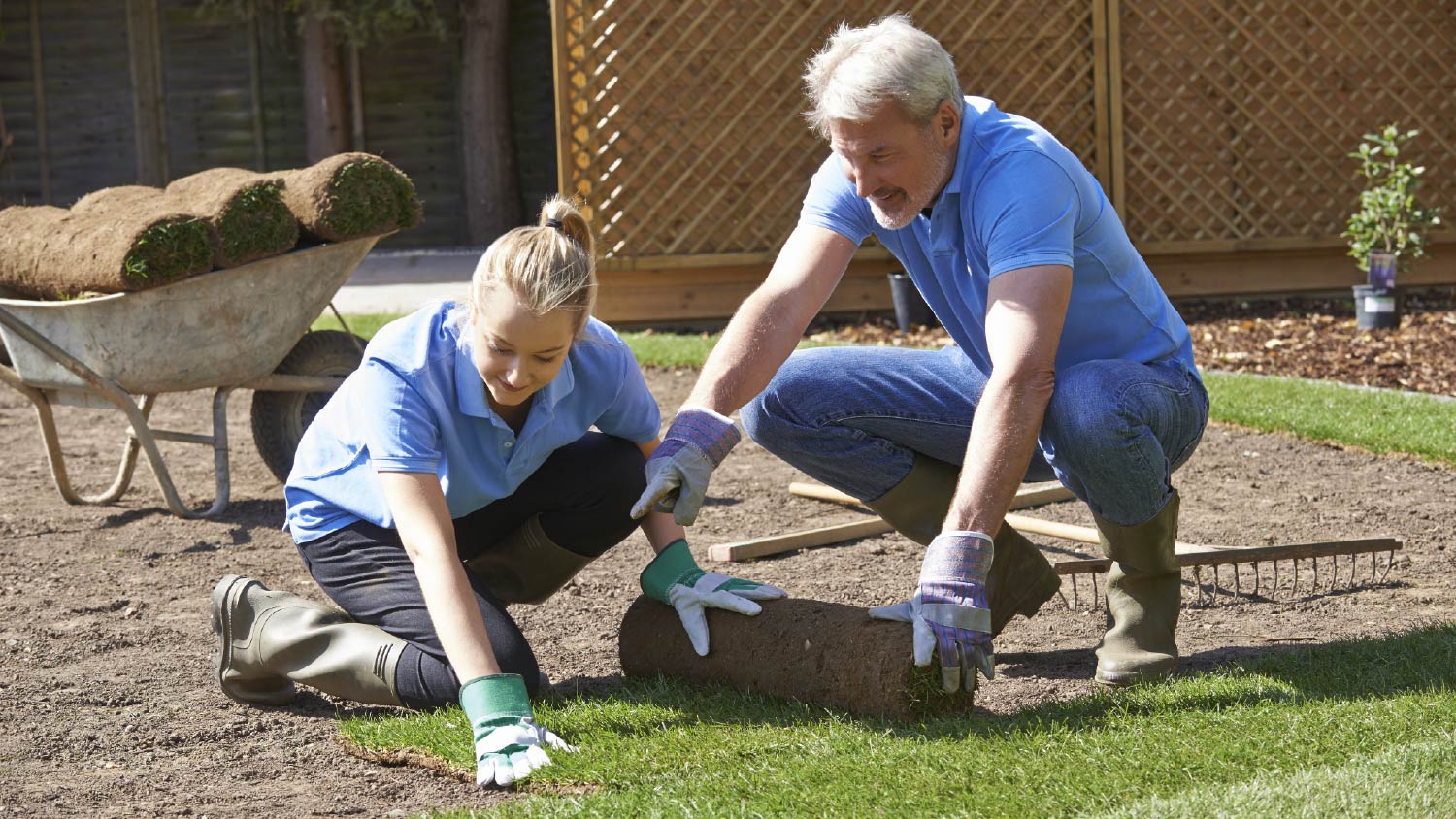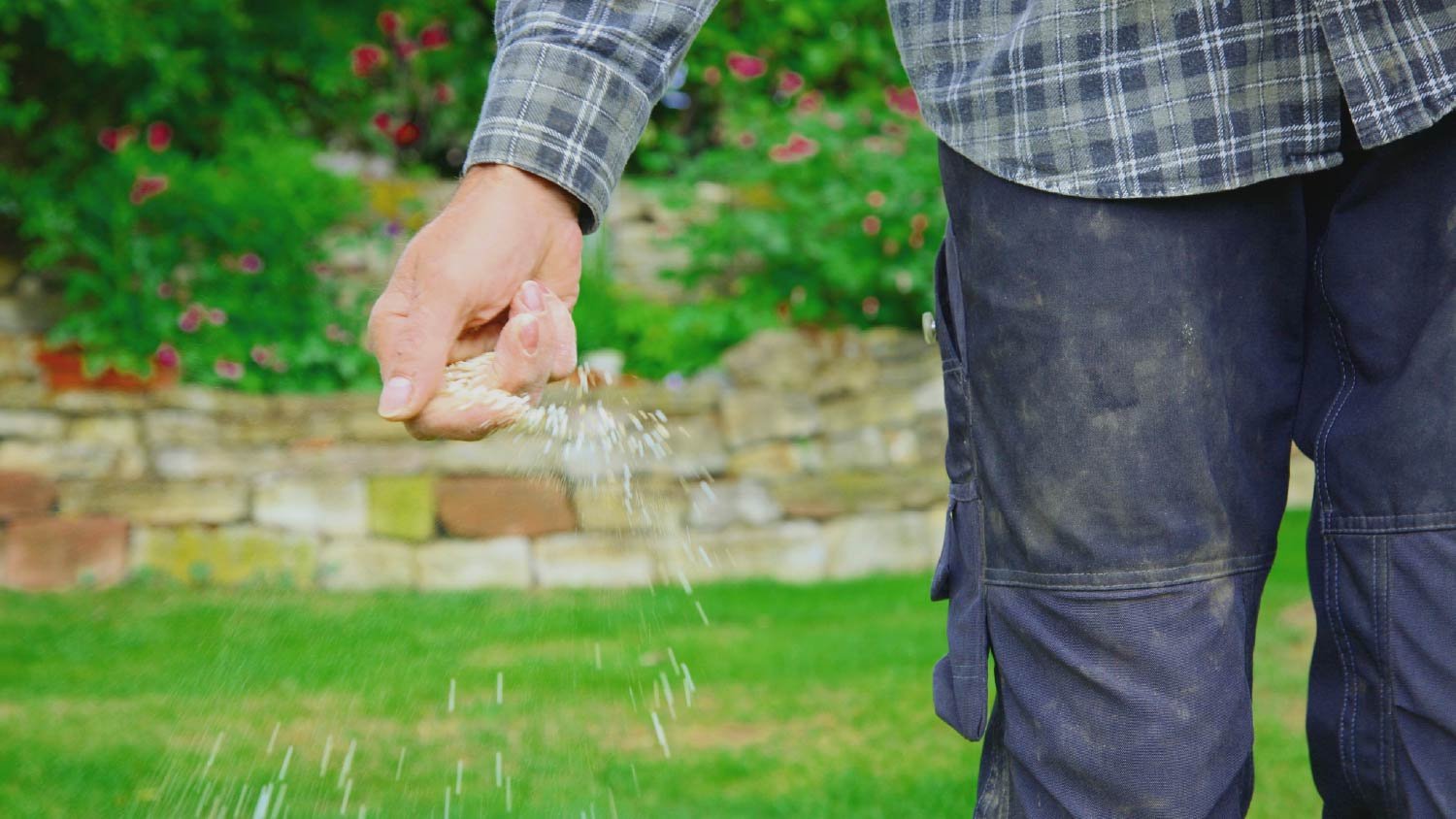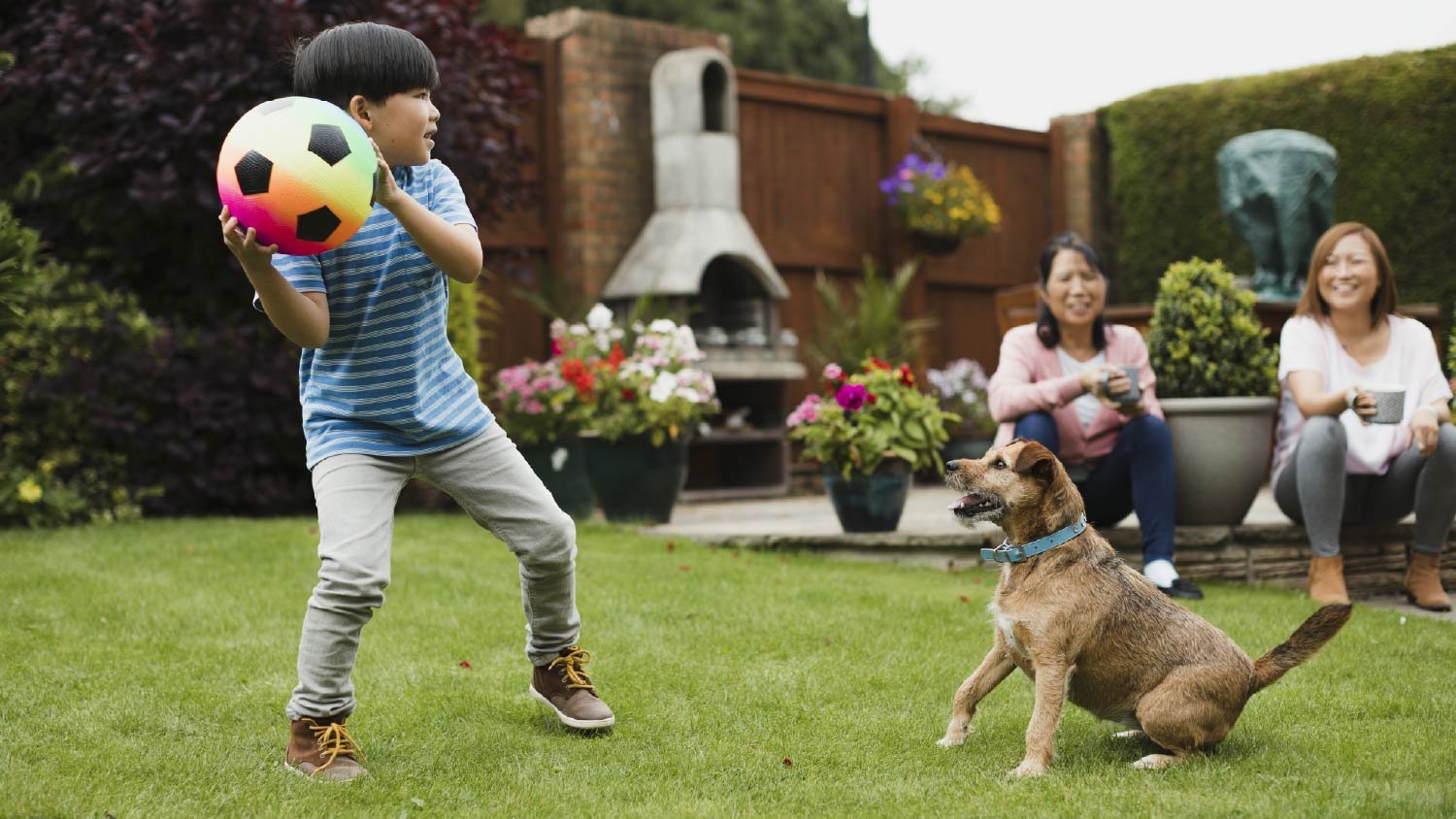Sod vs. Seed: What’s the Difference?
Here’s how to make the turf decision between sod and seed


Sod is pre-grown, ready-made grass that’s laid over bare soil and matures in two to three weeks.
Lawn seeding involves planting seeds straight into soil and takes several weeks to germinate.
Seed is best for repairing an existing lawn, while sod is used when growing a lawn from scratch.
Both seed and sod require time, labor, and thorough knowledge of best installation practices for optimal results.
Whether you’re looking to spruce up a lackluster lawn or start a new one from the ground up, you’re facing the age-old dilemma of sod vs. seed. While both sodding and seeding can grow the lush, healthy grass you’re after, each has its benefits and shortcomings. Let’s take a look at the differences between sod and grass seed to help you determine which will work best for your space.
Sod vs. Seed: Key Differences
Using sod or seed can help you achieve the lawn of your dreams. But these two popular methods share a few key differences. Sod is pre-grown and transplanted to your yard in rolls or blocks. Once it’s laid over bare soil, you instantly have a healthy, full, and mature lawn. Lawn seeding, however, involves planting seeds directly into the soil and giving them time to germinate and grow into a mature lawn. Grass seed can be sown on an existing lawn, while sod must be laid over bare soil.

What Is Sod?

Sod is essentially pre-grown rolls of grass that you have to install onto fresh soil. You can purchase sod from suppliers such as garden centers, farms, and home improvement stores. Laying sod can create an instant lawn for homeowners and offers immediate curb appeal.
| Pros | Cons |
|---|---|
| Instant installation | Higher installation cost |
| Takes root within two to three weeks | Fewer grass type choices |
| Outcompetes early weed growth | Harder to grow in shaded areas |
| Low maintenance | More labor-intensive installation |
Best for: Homeowners who want quick, effective results and low maintenance upkeep
Pros of Sod
The primary benefit of installing sod in your yard is that once installed, you have a relatively picture-perfect yard. Professional sod installers can lay sod any time and during any season, although it’s easiest in the early- to mid-fall. Sod takes root much faster than grass seed, with a turnaround time of two to three weeks. Once sod flourishes, it’s low maintenance to take care of with regular mowing and watering sessions.
Cons of Sod
The downside of installing sod is that it’s a much more expensive task than planting grass seed. Sod installation costs $1,100 to $3,000, depending on your yard’s size and condition. Plus, you’ll need to hire a team of sod professionals to install it for you.
Keep in mind that sod limits the type of grasses you can plant, and it struggles to grow evenly and quickly in shaded areas.
What Is Seeding?

Seeding is another option for growing grass in which you plant grass seeds to repair patches in an existing lawn or spread seeds over an entire area to completely restart a lawn. Planting seeds is an easy, low-cost way to liven up a few thin or bare spots and restore a lawn’s vibrancy.
Planting grass seed involves distributing seeds (either by hand or a push-operated broadcast spreader) that later germinate and sprout into fresh, new grass. This lawn care method is a cost-effective way to restore bare patches, such as around walkways, and expand the green space around your home.
| Pros | Cons |
|---|---|
| Less expensive | Slower results |
| Wide variety of grass choices | Weed interference |
| Low-skill installation | Requires ongoing maintenance |
Pros of Seed
The major advantage of planting grass through seeding is that it’s relatively inexpensive, as it only requires purchasing enough grass seed to cover the lawn and a seed spreading device. Seeding a lawn costs $450 to $1,800, depending on the grass type and lawn size. Plus, you can choose from a seemingly endless list of grass types based on which one grows best in your climate and soil type. You can choose to DIY the seeding process, knowing that it will take longer and more manual labor, or hire a lawn seeding service to tackle it for you.
Cons of Seed
There are several limitations to planting a lawn through grass seed. One drawback is that it takes much longer for grass to grow in—typically up to two months. During the initial growing period, there’s a higher risk of weeds interfering with the process, plus it requires ongoing upkeep like watering and fertilizing.
Sod vs. Seed

When it comes to choosing between sod versus seed, there isn’t a one-size-fits-all solution for everyone. Always take time, maintenance, and cost factors into consideration.
Installation Difficulty: Tie
Sod and seed are neck and neck when it comes to installation difficulty for DIYers. Both methods will require heavy labor and a significant amount of time. On one hand, sod comes pre-grown and only needs to be unrolled over your lawn. However, sod must be installed properly for optimal results. If not, your newly planted sod can die quickly.
On the other hand, seeding takes more initial effort. You’ll need to carefully plant, water, and nurture your grass seedlings until they germinate. However, even novice DIYers can usually succeed, as seeding is a straightforward process.
Maturity Time: Sod
Sod comes pre-grown and ready to unroll into an instant carpet of healthy grass. With proper installation and care, sod can establish a thriving lawn in just two to three weeks. All it takes is a little time for the newly-laid grass to take root, then the lawn is ready for friendly get-togethers, playing fetch with Fido, and enjoying the soft blades of grass between your toes.
As for how long it takes grass seed to grow, you’ll be waiting anywhere from seven to 21 days just for the seeds to germinate. From there, it needs at least one full growing season for the grass to become established enough to withstand regular use and foot traffic.
Repairing Lawn: Seed
To fix up areas of dead grass and bare soil, you’ll want to go with grass seed. Since you have to lay sod on bare soil, you’ll likely need to tear up a bunch of healthy grass just to fill in a few bare or sparse patches. Overseeding a lawn is much simpler and less invasive, whereas using sod to repair a lawn is usually excessive.
Bare Soil: Sod
When it comes to sod versus seed in bare soil, there’s a clear winner. Sod will be much more likely to give you a healthy, thriving lawn in a single try on top of bare soil.
Grass seed can be tricky to get right the first time around; seeds can get washed away in heavy rain, eaten up by hungry birds, or blown away in one strong gust of wind. If you choose to overseed, in many cases, you’ll need to overseed more than once to fill in the gaps before you can achieve a full, healthy lawn.
Grass Varieties: Seed
If you’re looking for a certain type of grass or your lawn has specific needs (like shade-tolerant grasses or drought-tolerant varieties), grass seed offers far more variety than sod. When choosing sod, you’re limited to what the manufacturer has ready, which may or may not be ideal for your lawn’s soil and sunlight.
Water Requirements: Sod
Sod and seed both require frequent watering during the early growing stages to establish a healthy soil. However, sod needs slightly more water at first, but after establishing, it’s more attune to drought conditions than grass. In the long run, seed needs more water to continue thriving.
Best DIY Project: Seed
Unfortunately, laying sod isn’t as simple as unrolling a green carpet. Without proper installation, sod won’t be able to take root in the soil and will quickly die. Not to mention that rolls of sod are extremely heavy, making them difficult to lift and transport. Sowing grass seeds and keeping them watered is a much simpler DIY.
Controlling Weeds and Erosion: Sod
If your yard has to contend with obstacles such as weeds and soil erosion, sod will probably be your best bet. Again, freshly-sown grass seeds can easily get washed away during periods of rain or flooding, so sod will be better suited for areas prone to erosion. Weeds, on the other hand, will compete with new grass seeds for soil moisture and nutrients, and they’ll usually win.
Cost: Seed

While grass seed lacks instant results, you’ll save a bundle by opting to use it for your lawn project. The average cost of sod installation is around $2,000, or between $1.20 and $2.85 per square foot. On the other hand, the average cost to seed a lawn is a bit more budget-friendly at $450 to $1,700, or about $0.10 to $0.20 per square foot.
With the money you save buying seed versus sod, you may bank enough to hire a local lawn seeding company to do the hardest part of the job for you.
Frequently Asked Questions
The best time to spread grass seed is during late summer or early fall, allowing the seeds enough time to germinate before winter and gain the upper hand against summer weeds. Don’t seed during winter or early spring, as soil and air temperatures will be too cold to allow the grass to thrive and could kill them for good.
If half or more of your lawn consists of dead grass or weeds, it’s better to start over with laying sod. Sod is also a better choice if you prefer instant curb appeal and a quick turnaround time. Additionally, if you’re starting a brand new yard and have nothing but bare soil, sod is a better choice than seed for creating a healthy lawn.
Seeding offers more bang for your buck since it has a lower upfront cost than sodding. Seeds also come in a wider variety of grass types than sod strips and require less intensive labor to install. However, sod may offer more protection against weeds and erosion, so keep your budget, yard type, and preferred grass variety in mind before choosing.
While laying sod on an existing lawn can seem like a way to save time, it can kill your lawn and create more landscaping issues. Newly laid sod must reach the soil to form roots and produce new, healthy grass. Without soil contact, any sod that does manage to grow will likely die in just a few short weeks. Additionally, throwing sod on an existing lawn can lead to drainage problems and an unsightly lawn.





- What Is Sod? Everything You Need to Know
- How to Lay Sod: A Step-by-Step Guide for a Beautiful, Lush Lawn
- Can You Lay Sod Over Existing Grass? What to Know Before You Start
- How to Fix Patchy Grass: A Complete Guide
- The Best Time to Lay Sod: A Complete Guide
- How Long to Water New Sod With Sprinkler Systems: Your Guide to a Healthy New Lawn
- When To Mow New Sod: What You Need to Know
- How Much Does a Pallet of Sod Cover?
- How to Grow Grass Fast: 8 Steps for a Rapidly Lush Lawn
- How to Seed a Lawn For Lush and Healthy Results










